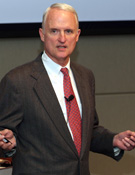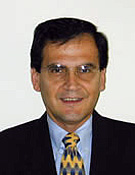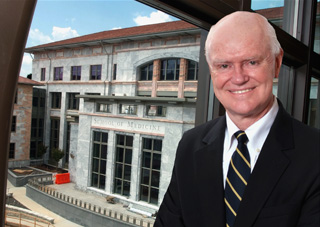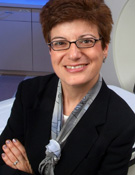 |
||
June 2009 |
||
Conflict of interest in academic medicineAs you have heard, the SOM has rolled out an updated conflict of interest (COI) policy. I can't stress enough how important this policy is, so I hope each of you will carefully and thoroughly read it. Now more than ever, I believe the SOM needs a clear road map to lead us safely through what can become a thicket of COI-related issues. While there are only a small percentage of researchers nationally who don't adhere to COI guidelines, we all must take care to avoid the perception of impropriety. The public has a growing perception that the biomedical industry has permeated every aspect of medicine and, as a result, has become wary. While the SOM wants to continue our relationships with pharmaceutical companies, device manufacturers, and other industry, we want to verify continually that these collaborations are principled. That is why I commissioned a COI task force, which made preliminary recommendations in 2007 and which the SOM Council of Chairs refined and strongly supports. Our new COI policy was crafted carefully over time, with consideration of similar policies developed by the Association of American Medical Colleges and other institutions, including the Institute of Medicine, and universities. To help you through the policy's approval process, the SOM will post a new web page soon. All you will need to do is upload any contracts and agreements for review and complete a short questionnaire. The Council of Chairs also is considering a web page that lists faculty's financial relationships, much like the Cleveland Clinic's. Our new policy may not always prevent the accidents of human nature, but it may help us avoid the six-car pile-up that COI issues can cause. Tristram Parslow, who served as the SOM's task force co-chair (2006-07) and is chair of the university’s commission on conflict of interest, put it perfectly when he said, "We never see our own conflicts of interest the way others see them. I always ask two questions, 'How would this look in the newspaper, and why does this company love me?' The processes are not perfect, but the stakes are very high."
Blueprint for research: create, advance, inspire Raymond Dingledine Raymond Dingledine
This fall you will be introduced to the SOM's latest five-year research strategic plan 2009-2010, coordinated by Raymond Dingledine, Executive Associate Dean for Research and Chair of Pharmacology, and Carolyn Meltzer, Chair of Radiology. They are heading up a multidisciplinary team of 27 faculty to devise the plan. To see where we are going in the next five years, remember where we have been. In the late 1980s, the goal of the SOM’s research strategic plan was to strive for national prominence. Once an academic center with regional stature, the SOM now has substantial national recognition. Jumping ahead to the 1997-2002 plan, we moved research forward by recruiting more investigators. "The SOM reached a critical mass of investigators by 2002," says Dingledine, who co-authored the 1997 plan and the subsequent one that was released for 2003-2009. "In 2003, our overall focus was to build multidisciplinary teams that work on common diseases or health problems." The result was cancer SPOREs (Specialized Projects of Research Excellence funded by the NIH), program project grants, and the development or expansion of key research centers, such as the Emory Winship Cancer Institute. Our strategic research plans played a key part in the SOM catapulting from $55 million in NIH funding to $228 million in 2008. So what lies ahead for SOM research? We will improve the infrastructure to better support creativity among investigators. This will involve expanding core facilities, providing real incentives for team research, removing administrative barriers that slow collaborative research, and streamlining the grants process. We will further develop partnerships outside the SOM, including, but not limited to, Children's Healthcare, Georgia Tech, VA, Grady, other Emory schools, and, especially, Emory Healthcare. Even though the SOM and EHC have the shared goal of providing the latest, most advanced care, we have different cultures and need to work on sharing credit, revenues, and costs to enhance our collaborative environment. "When we interface, breakthroughs are possible," Dingledine says. Granted, economic conditions have placed special considerations onto the 2009 plan. "We have to show initial austerity going forward," says Dingledine. With economic uncertainty, the SOM will have to move appropriate resources to the right areas. To address this, the SOM is looking ever more closely at how to utilize its already limited research space. In the future, we can expect that the Obama stimulus plan will channel new resources toward research over the next two years, and we will be ready. There are new opportunities for translational research, and our new research plan will help build the foundation.
Microbiology and Immunology has new chair Jeremy Boss I am pleased to announce that Jeremy Boss has assumed the position as Chair of the Department of Microbiology and Immunology effective June 1. He has been on the faculty at the SOM since 1986 and is the former director of Emory's graduate program in genetics and molecular biology. "While the department is already at an excellent level, our major goal over the next five years is to enhance our scholarly and teaching activities," says Boss. "We will recruit new faculty in areas related to microbial pathogenesis and host defense mechanisms and seek to synergize our activities with those of other departments across the SOM and the Woodruff Health Sciences Center." Boss is editor-in-chief of the Journal of Immunology, one of the most cited publications in biomedicine, and is the author of the popular book for career development, Academic Scientists at Work: Navigating the Biomedical Research Career. Boss's research at Emory has focused in part on molecular mechanisms of regulation of immune system genes; regulation of human major histocompatibility complex class II genes, regulation of genes by tumor necrosis factor, and regulation of the programmed death-1 gene and its relationship to T cell exhaustion and disease.
Ahmed elected to National Academy of Sciences Rafi Ahmed Rafi AhmedRafi Ahmed, Professor of Microbiology and Immunology and a Georgia Research Alliance (GRA) Eminent Scholar, recently was elected as a member of the National Academy of Sciences. He is Director of the Emory Vaccine Center. Ahmed is the third Emory scientist to be a member of the academy; Max Cooper, an immunologist and a GRA Eminent Scholar, and Frans de Waal of the Yerkes National Primate Research Center are also members. This honor, which recognizes American scientists for their distinguished achievements in original research, is one of the most prestigious recognitions in science. Ahmed's groundbreaking discoveries on immune memory have laid the foundation for understanding vaccine-induced immune responses. His most recent work has focused on rejuvenating the immune response to chronic viral infections. This holds great promise for those infected with HIV/AIDS and other chronic infectious diseases such as hepatitis and tuberculosis, and it also has potential for treatment of cancers. "We were very fortunate to recruit Rafi," says Richard Compans, Professor of Microbiology and Immunology, who was instrumental in getting Ahmed to Emory in 1995 from the UCLA School of Medicine. "It was clearly evident, early in his career, that Rafi was an outstanding investigator who would make major contributions to immunology and vaccine research. His leadership and vision have enabled Emory to be recognized internationally as one of the leading centers for vaccine science and the nation's pre-eminent academic vaccine center." Ahmed's research articles in scientific journals have been cited as among the leading all-time scientific publications. An article in the journal Nature in February 2006 was ranked as the top immunology paper by the Faculty of 1000 Biology and as the fourth leading paper in all of biology. He has received numerous grants for his research, including a $12.5 million Grand Challenges in Global Health grant in 2005 from the Bill & Melinda Gates Foundation for research on hepatitis C virus infections, a $4.5 million grant from the Gates Foundation in 2006 for HIV vaccine research, and a $13 million grant from the NIH in 2008 for work on the molecular pathway called PD-1 (programmed death 1). Spotlight on urology Fray Marshall Fray Marshall Do you know that everyone experiences a urological problem sometime during his or her lifetime? That most men will have an enlarged prostate? That about 40% of women will have elements of incontinence? "At some point, men have problems with obstruction and women with incontinence," says Fray Marshall, chair of urology. "So it’s time to get a better perspective on what urology is all about." The Department of Urology is one of the most sought-after centers for residency training, with 75% of all medical students interested in urology applying to Emory for their residencies. The caliber of faculty in the department helps explain why. Following are some examples of their recent work:
Recent awards and honors Guillermo E. Umpierrez Guillermo E. Umpierrez
The American Association of Clinical Endocrinologists named Guillermo E. Umpierrez, Chief of Diabetes and Endocrinology at Grady Memorial Hospital, the 2009 recipient of the Outstanding Service Award for the Promotion of Endocrine Health of an Underserved Population. Sheryl Heron received the 2009 Marcus Martin Leadership in Diversity Award of the Society for Academic Emergency Medicine. The award is given for her effort to implement research, teaching, and service initiatives that embrace the value and impact of diversity in emergency medicine. A Festschrift was held for Donald Stein, Asa G. Candler Professor of Emergency Medicine, at the 21st annual convention of the Association for Psychological Science in late May. Stein's research has long examined the processes underlying recovery of function after traumatic brain injury, producing major contributions to the field. He continues to build on his distinguished research program and is currently focusing on determining the physiologic substrates responsible for progesterone's beneficial effects in the treatment of traumatic brain injury. Psychiatry Professor Claire Coles will be honored later this month as a distinguished leader by the National Organization on Fetal Alcohol Syndrome. Coles, who also serves as Director of the Fetal Alcohol and Drug Exposure Clinic at Marcus Autism Center, will be one of three honorees at a Washington reception hosted by former senator Tom Daschle. Seema Shah 09M 10MPH will travel to India in early August as a Fogarty International Clinical Research Scholar. The fellowship offers a one-year clinical research training experience for mentored research training at an NIH-funded research center in a developing country. Jessica Manning 10M is returning this summer from Mali, where she worked at the University of Bamako's Malaria Research and Training Center, and before her, Shelene Poetker Hurst 09M worked in Brazil as a Fogarty Scholar. The Association for Research in Vision and Ophthalmology announced this year's inaugural class of distinguished fellows, which include three SOM scientists: Henry Edelhauser, Hans Grossniklaus, and John Nickerson. William Fajman was inducted into the American College of Radiology. He is Chief of Clinical Nuclear Medicine at Grady and an Associate Professor at the SOM. |
||
 |
||

 Carolyn Meltzer
Carolyn Meltzer  Sheryl Heron
Sheryl Heron Donald Stein
Donald Stein